
Source: Markus Spiske/Pexels
The “problem of obviousness” in psychology is that non-experts often have a “So what?” response to new findings. This has been explained as a hindsight bias in which, once something appears to have occurred, the mind makes sense of it. When it comes to human behavior, this is all the more likely, because we are familiar with many of its variations and possible explanations, both real and fictitious.
As though in response to this problem, some psychologists, thinking outside the box, have come up with quite counterintuitive hypotheses. This not only preempts “So what?” reactions, it is also attention-grabbing. Nonintuitive hypotheses and findings come as a surprise. They are novel, and science is about new discoveries.
Some nonobvious hypotheses and findings in psychological science are described below. It is interesting that they share features with certain literary and cinematic works and genres. Although nonobvious in a scientific context, their insights were, in some cases, foreshadowed in fiction. This may have contributed to their impact and resonance in the scientific community and, in some cases, in popular culture.
Psych Sci or Sci Fi?
In some instances, psychological science has a science-fiction quality to it. For example, there is the “Illusion of Authorship,” according to which humans have only the false impression of possessing a conscious will, a self, a mind, and causal agency. Part of this is undoubtedly true: People generally believe they possess authorship in these ways.
It’s the part about this being an illusion that, if true, is nonobvious. Depictions of this scenario abound in science fiction, running the gamut from I, Robot to the Matrix film trilogy.
The Future Ain’t What it Used to Be
The results of Solomon Asch’s conformity research, and especially Stanley Milgram’s obedience studies, were surprising and impactful. In response to perceived social pressure, Asch’s subjects made judgments about visual stimuli that contradicted what they plainly saw.
Milgram’s subjects were willing to deliver electric shocks to another person in the context of a staged learning experiment to a greater extent than predicted by Yale students, colleagues, and 40 psychiatrists that Milgram polled ahead of time.
Both lines of research capture themes common to dystopian fiction. Like science fiction, dystopian fiction engages in speculative exploration of human nature. But it is generally more pessimistic and focuses more on society than science and technology.
Many dystopian futures have been depicted in which extremes of conformity and obedience to authority reign. And, to come back to the illusion of authorship, deference to social norms and authority, in many instances, is enabled by the populace’s false sense of autonomy and individual agency. Among notable examples are the novels 1984 and Brave New World.
Take the Obvious and Reverse It
It adds to the “wow” factor when a nonobvious hypothesis is not merely unexpected or nonintuitive but conjures a reality that, in some way, is the direct opposite of what was thought to be.
One of the most famous examples in psychology is William James’s suggestion that rather than emotional feeling causing bodily reactions, it goes the other way around: We are afraid because we flee danger and sad because we cry.
Drawing on this idea and Charles Darwin’s suggestions about the functions of facial expressions of emotion, Silvan Tomkins proposed that emotional feelings are generated when afferent nervous signals caused by the facial muscle movements associated with emotions provide feedback to the brain.
Another instance of reverse-the-obvious theorizing comes from social psychology, the field in which counterintuitive hypotheses may be most prized. A field in which attitudes have long been a significant focus for their potential to explain social behavior.
Psychology Essential Reads
Leon Festinger’s cognitive dissonance theory proposed that dissonance, a state of discomfort caused when a person experiences inconsistency between their attitudes and behaviors, can be reduced through a process in which the attitude is modified to align more closely with the behavior: Behavior causing attitude, instead of the other way around. Specific demonstrations were highly counterintuitive, such as a person performing a tedious task for a very small payment finding the task more interesting than those doing the same task for a larger payment.

Source: Pixabay/Pexels
There are many works of fiction in which reality turns out, in some sense, to be radically different from what had been thought. This is the essence of the “twist” ending, present in many films, a staple of TV episodes in Twilight Zone and Outer Limits, and virtually a defining element of the short story. And in some way, there is a twist in the ending to every nonobvious research finding.
But not all these fictitious endings and scientific conclusions completely reverse reality, revealing a state of affairs truly the opposite of what had been thought, as in the suggestions of James and Festinger, where the causal arrow is reversed.
Alert: Spoilers Ahead
My all-time favorite in fiction is an episode of the original Twilight Zone TV series. At first, the human race seems to face extinction by fire as the earth is discovered to be moving closer to the sun. But this turns out to be someone’s fever-induced nightmare: On awakening, they find it will instead be extinction by ice, as the earth is actually moving away from the sun.
Others that come to mind are the films Sixth Sense, in which the main character, unbeknownst to himself, is actually dead, and Planet of the Apes, in which a world dominated by highly evolved yet warlike apes is not a far distant planet, but the earth’s future.
Obviousness and Obliviousness
There are two levels of nonobviousness in these research examples. First, the hypotheses run counter to intuition. The absence of authorship, conformity, obedience, running/crying generating fear/sadness and behaviors causing attitudes, violate common sense rather than confirming it.
Second, in the reality suggested by the research, there is something else we humans are incapable of or do not know: autonomy, conscious will, and where our emotions and attitudes come from. Other findings send similar messages, including work on implicit attitudes (we do not even know our attitudes, much less what causes them), affective forecasting (our anticipated emotional reactions to future events are inaccurate), and positive illusions (which preserve a more favorable view of ourselves, the world, and the future than is objectively real).
To be fair, psychological science also suggests ways humans know more and are capable of more than conventional wisdom would suggest. Examples include but are not limited to the extraordinary talents of certain individuals and our general capacity for adaptation, resilience, learning, and acts of kindness.
More importantly—and this does not diminish the creativity they reflect nor their heuristic value in generating ideas and research—none of the examples of nonobvious findings described earlier are established scientific fact. They and their purported implications have all been contested or qualified, and some are known to be untrue.
The unexpected automatically grabs our attention; that is human nature. Whether we should dismiss it as real but trivial, accept it as novel insight, or reject it is often not obvious.
Copyright 2023 Richard J. Contrada





















+ There are no comments
Add yours